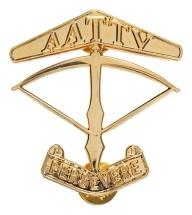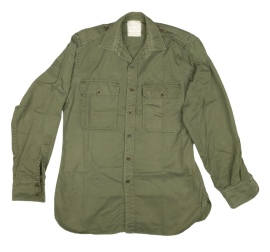Warrant Officer Class 2 Rayene Simpson
Amid a downpour, the sound of gun-fire rang out through the South Vietnamese jungle. Warrant Officer Ray Simpson and his men had fought hard against the Viet Cong, and it was time to get out. Ordering his men back, he covered their withdrawal with smoke grenades while carrying a wounded mate. Ray refused to leave until the last of his men was safely away.
Rayene Stewart Simpson, or Ray, was born in Sydney on 16 February 1926. Separated from his siblings when his mother disappeared in 1931, Ray was placed in an orphanage. Having left school aged 12, Ray was working as a labourer outside Taree, New South Wales, when the Second World War began in 1939. Too young to enlist, he waited five years, joining the army just four weeks after his 18th birthday.
Ray fitted well into army life, and fought on Morotai, Borneo, and New Guinea during the Second World War. He re-joined the army in 1951, serving with the 3rd Battalion, Royal Australian Regiment (3RAR) in Korea, and was promoted several times, eventually reaching the rank of sergeant. During a rest period in Japan, Ray met Sakai Shoko, whom he married on 16 January 1953, less than a month after their first meeting.
Ray served two years in Malaya (now Malaysia) during the Malayan Emergency, then returned to Australia to join 1 SAS Company. Selected for the Australian Army Training Team Vietnam (AATTV), Ray provided advice on the training and operations of South Vietnamese armed forces and accompanied units on field operations. He completed three tours to Vietnam, his last from 1967 to 1970.
Warrant Officer Class 2 Ray Simpson crosses a makeshift bridge in the Mekong Delta, South Vietnam, September 1969. (Brian Edwin L’Estrange)
On 16 September 1964, during his second operational tour in Vietnam, Ray was awarded the Distinguished Conduct Medal for his actions against the Viet Cong. Despite suffering a serious leg wound, Ray demonstrated inspirational leadership following the loss of the unit’s commander. After recovering from his wounds, Ray returned to Australia in 1966 and chose to be discharged. However, he missed the army “mob” and Shoko, who was in Japan, and paid his own way back to Saigon and re-enlisted in 1967.
Ray is loaded on board an Iroquois helicopter after being wounded, 1964.
Two years later, while commanding the 232nd Mobile Strike Force Company during a search-and-clear operation in South Vietnam, Ray saw one of his platoons come under heavy fire. Despite the danger, he went ahead of his troops in an assault on the enemy position, attracting enemy fire towards himself. As the troops moved forward, Warrant Officer Mike Gill was fatally wounded. Ray raced to his side, picked him up and carried him to a position out of range. Returning to the action, he crawled within ten metres of the enemy position and hurled grenades. As night fell, Ray ordered his men to pull back, and picking up his wounded mate, threw smoke grenades to cover their withdrawal.
Five days later, Ray’s battalion again came under heavy fire, resulting in many casualties. To cover their evacuation, Ray went forward alone and, positioning himself between the enemy fire and the wounded men, held the enemy back, allowing his men to withdraw.
For these actions, Ray was awarded the Victoria Cross. The citation for his award concluded: “Warrant Officer Simpson’s repeated acts of personal bravery in this operation were an inspiration to all … who served with him.”[1]
Ray attended the ceremony to receive his Victoria Cross in May 1970 with his beloved wife, Shoko.
Ray left the army for the final time in May 1970, three days after receiving his Victoria Cross. Returning to Tokyo with Shoko, Ray took up work as an administrative officer at the Australian Embassy. He died in October 1978, aged just 52.
Ray’s dedication to the army was matched only by his devotion to his wife. In an article published in 1969, Ray explained his three tours to Vietnam:
I keep extending service because of my Japanese wife, Shoko. She has to stay in Japan at the moment because her mother has a bad heart. So being up here [Vietnam] I get extension leave every time I decide to stay on. That way I can see her for 30 days.[2]
Activities
- Ray was a member of the Australian Army Training Team Vietnam (AATTV). Research the role of the AATTV.
- Three other Australians were awarded the Victoria Cross for bravery during the Vietnam war: Warrant Officer Keith Payne, Major Peter Badcoe, and Warrant Officer Kevin “Dasher” Wheatley. All three were, like Ray, members of the AATTV. Investigate their service and find out why they were also awarded the Victoria Cross.

An AATTV hat badge.
3. Referring to the image below, what advantages might the uniform worn by Australians serving in Vietnam have provided? Can you think of any disadvantages?

During the Vietnam War Australian troops wore shirts known as “jungle greens”. The cotton shirts were light olive in colour.
- Ray married Japanese woman Sakai Shoko in 1953 when the White Australia policy was still in place. What challenges may Ray and Shoko have experienced during this time? When were Japanese war brides allowed to immigrate to Australia?
- As a result of the Vietnam War, thousands of Vietnamese people arrived in Australia seeking asylum. Investigate the story of one Vietnamese person who made a new life in Australia. Examples include Tam Tran, Anh Do, Lam Tac Tam, and Pauline Nguyen. You can read about Tam Tran in the Control publication.
Related objects
- Jungle green shirt
- Australian Army Training Team Vietnam (AATTV) hat badge
- Australian field ration eating device
- Survival card
- Translated phrases
- Magnifying glass
Footnotes
[1] Rayene Simpson papers, Australian War Memorial, AWM PR00455
[2] “Wounded”, The Sun, 22 August 1969, p. 3
Bibliography
Anthony Staunton, Victoria Cross: Australia’s finest and the battles they fought, Hardie Grant Books, Melbourne, 2005.
Lionel Wigmore and Bruce Harding, They dared mightily, Australian War Memorial, Canberra, 1963.



